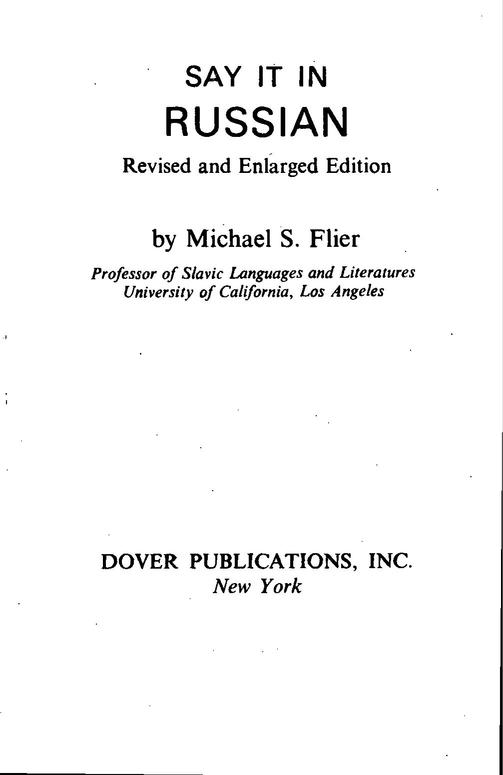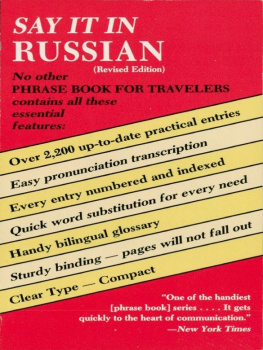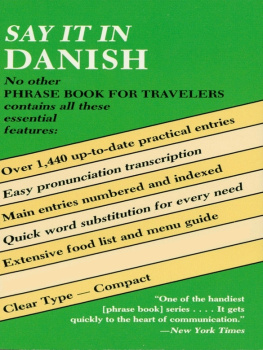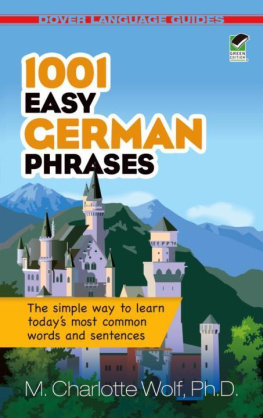LISTEN & LEARN CASSETTES Complete, practical at-home language learning courses for people with limited study timespecially designed for travelers. Special features: Dual-languageEach phrase first in English, then the foreign-language equivalent, followed by a pause for repetition (allows for easy use of cassette even without manual). Native speakersSpoken by natives of the country who are language teachers at leading colleges and universities. Convenient manualContains every word on the cassettesall fully indexed for fast phrase or word location. Each boxed set contains one 90-minute cassette and complete manual.
| Listen & Learn French | Cassette and Manual
99914-9 |
| Listen & Learn German | Cassette and Manual
99915-7 |
| Listen & Learn Italian | Cassette and Manual
99916-5 |
| Listen & Learn Japanese | Cassette and Manual
99917-3 |
| Listen & Learn Modern Greek | Cassette and Manual
99921-1 |
| Listen & Learn Modern Hebrew | Cassette and Manual
99923-8 |
| Listen & Learn Russian | Cassette and Manual
99920-3 |
| Listen & Learn Spanish | Cassette and Manual
99918-1 |
| Listen & Learn Swedish | Cassette and Manual
99922-X |

Fr Elysewhen youre back in the U.S.S.R.
The Dover Say It series is prepared under the editorial supervision of R. A. Sorenson. Copyright 1982 by Dover Publications, Inc. All rights reserved under Pan American and International Copyright Conventions. This Dover edition, first published in 1982, is a completely revised and enlarged work, which supersedes the book of the same title originally published by Dover Publications, Inc., in 1954.
Manufactured in the United States of America
Dover Publications, Inc.
180 Varick Street
New York, N.Y. 10014 Library of Congress Cataloging in Publication Data Flier, Michael S. Say it in Russian. (Dover say it series) Rev ed. of: Say it in Russian/N. Stepanoff. 1954. 1954.
Includes index. 1. Russian languageConversation and phrase booksEnglish. I. Stepanoff, N. C.
Say it in Russian. II. Title. PG2121.F53 1982 491.783421 82-7292 9780486149318 AACR2 Table of Contents
INTRODUCTION Say It in Russian is based on Contemporary Standard Russian, the literary norm of the Russian language as spoken in the Soviet Union today. Although the standard language is based on the Central Russian dialect spoken in Moscow and differs in a number of respects from the spoken dialects of northern and southern Russia, it is readily understood by all Russian speakers and by most Soviet citizens whose first language is not Russian. Russian is related to most of the languages of Eastern Europe.
As a Slavic language, it falls into the East Slavic group along with Ukrainian and Belorussian (White Russian). The West Slavic group includes Czech, Slovak and Polish, while Bulgarian and Serbo-Croatian are among the South Slavic languages. The 1980 edition of The World Almanac estimates that there are 259 million speakers of Russian, a figure that places it third, after Mandarin Chinese and English, among the major languages of the world. NOTES ON THE USE OF THIS BOOK Say It in Russian is divided into sections by topics geared to various situations likely to be encountered by the traveler in the Soviet Union. Such topics include social conversation, travel, eating, shopping, health and illness. The entries in most sections are alphabetized according to their English headings; exceptions are the sections on food and public notices and signs, which are alphabetized according to the Russian to permit quick and easy reference.
In the extensive index at the end of the book, capitalized items refer to section headings and give the number of the page on which the section begins. All other numbers refer to the separate, consecutively numbered entries. The index itself serves as a useful English-Russian glossary; any word not in the section where you expect to find it is likely to be in the index. Say It in Russian contains words, phrases and sentences likely to be essential for travel in the Soviet Union. This material will serve as an interesting introduction to spoken Russian if you plan to study the language, but will be useful whether or not you study Russian on a formal basis. With the aid of the index, a guidebook, or an English-Russian dictionary, many sentence patterns here will answer innumerable needs.
For example, the slot occupied by Red Square in the sentence How long does it take to walk to [Red Square]? may be filled by any other word or phrase denoting a nearby destination, such as Gorky Street or Hotel Rossiya. In other sentences, the words in square brackets can be replaced with words immediately following (in the same sentence or in the indented entries below it). For example, the entry Turn [left] [right] at the next corner. provides two sentences: Turn left at the next corner and Turn right at the next corner. Three sentences are provided by the entry Give me a seat [on the aisle].
- by a window.
- by the emergency exit.
As your Russian vocabulary grows, you will find that you can express an increasingly wide range of thoughts by the proper substitution of words in these model sentences. A slash is used to separate alternative entries when an English word can be translated by Russian words which are not synonymous: Factory (heavy industry/light industry).
3a


/





.
Please note that while brackets always indicate the possibility of substitution, parentheses have been used to provide additional information. They are used to indicate synonyms or alternative usage for an entry: Hello (OR: Hi). Occasionally, parentheses may be used to clarify a word or to explain something unfamiliar to English speakers (such as Russian foods). The abbreviation (LIT.) is used whenever a literal translation of a Russian sentence is provided. Parentheses are also used to indicate words that can readily be omitted: We forgot our keys.  (
(

 )
)  .
.
The Russian word for our is often omitted from this phrase. Parentheses also indicate different forms of the same word that vary according to gender or number. Though it is not the purpose of this book to teach Russian grammar, parentheses are used to clarify grammatical points necessary for producing correct phrases. Nouns in Russian are either masculine (M.), feminine (F.) or neuter (N.). Adjectives, pronouns, participles and past-tense verbs also vary according to gender and whether they are singular (SG.) or plural (PL.). The entry I am a student is translated in either of two ways, depending on whether the speaker is male or female: 
Next page












 Fr Elysewhen youre back in the U.S.S.R.
Fr Elysewhen youre back in the U.S.S.R. 
 /
/



 .
.  (
(

 .
.